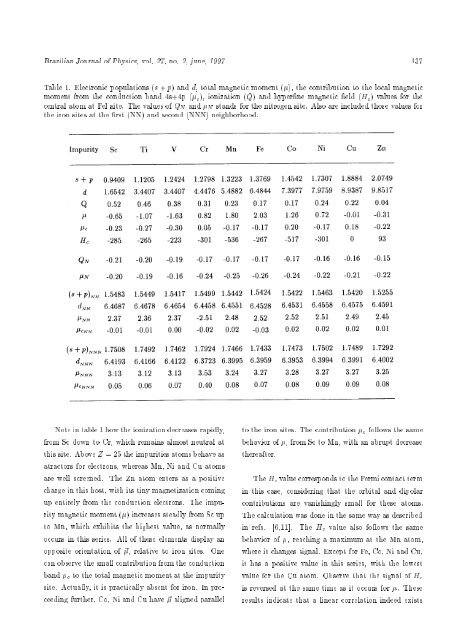Electronic Structure of Substitutional 3D Impurities in $\gamma
Electronic Structure of Substitutional 3D Impurities in $\gamma
Electronic Structure of Substitutional 3D Impurities in $\gamma
Create successful ePaper yourself
Turn your PDF publications into a flip-book with our unique Google optimized e-Paper software.
Brazilian Journal <strong>of</strong> Physics, vol. 27, no. 2, june, 1997 137<br />
Table 1. <strong>Electronic</strong> populations (s + p) andd, total magnetic moment (), the contribution to the local magnetic<br />
moment from the conduction band 4s+4p ( c ), ionization (Q) andhyperne magnetic eld (H c )values for the<br />
central atom at FeI site. The values <strong>of</strong> Q N and N stands for the nitrogen site. Also are <strong>in</strong>cluded those values for<br />
the iron sites at the rst (NN) and second (NNN) neighborhood.<br />
Note <strong>in</strong> table 1 how the ionization decreases rapidly,<br />
from Sc down to Cr, which rema<strong>in</strong>s almost neutral at<br />
this site. Above Z = 25 the impurities atoms behave as<br />
atractors for electrons, whereas Mn, Ni and Cu atoms<br />
are well screened. The Zn atom enters as a positive<br />
charge <strong>in</strong> this host, with its t<strong>in</strong>y magnetization com<strong>in</strong>g<br />
up entirely from the conduction electrons. The impurity<br />
magnetic moment() <strong>in</strong>creases steadly from Sc up<br />
to Mn, which exhibits the highest value, as normally<br />
occurs <strong>in</strong> this series. All <strong>of</strong> these elements display an<br />
opposite orientation <strong>of</strong> ~, relative to iron sites. One<br />
can observe the small contribution from the conduction<br />
band c to the total magnetic moment at the impurity<br />
site. Actually, it is practically absent for iron. In proceed<strong>in</strong>g<br />
further, Co, Ni and Cu have ~ aligned parallel<br />
to the iron sites. The contribution c follows the same<br />
behavior <strong>of</strong> , from Sc to Mn, with an abrupt decrease<br />
thereafter.<br />
The H c value corresponds to the Fermi contact term<br />
<strong>in</strong> this case, consider<strong>in</strong>g that the orbital and dipolar<br />
contributions are vanish<strong>in</strong>gly small for these atoms.<br />
The calculation was done <strong>in</strong> the same way as described<br />
<strong>in</strong> refs. [6,11]. The H c value also follows the same<br />
behavior <strong>of</strong> , reach<strong>in</strong>g a maximum at the Mn atom,<br />
where it changes signal. Except for Fe, Co, Ni and Cu,<br />
it has a positive value <strong>in</strong> this series, with the lowest<br />
value for the Cu atom. Observe that the signal <strong>of</strong> H c<br />
is reversed at the same time as it occurs for . These<br />
results <strong>in</strong>dicate that a l<strong>in</strong>ear correlation <strong>in</strong>deed exists















